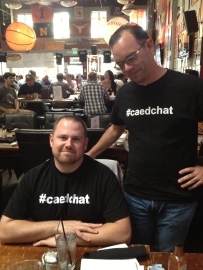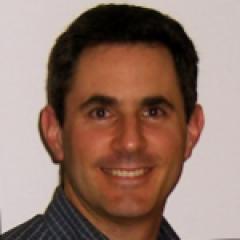Professional Development Goes Rogue
My last professional development experience occurred at a bar, with a pitcher of beer passed among participants at the table. Don’t worry – no district funds were misspent. It was my second time joining an informal evening tweet-up (i.e., organized on Twitter) of Computer-Using Educators (CUE) in the San Francisco Bay Area. These gatherings go by the hashtag #brewcue. There’s an occasional afternoon version – same idea, more caffeinated – called #coffeecue, with gatherings popping up in a wider variety of locations.
I won’t be able submit any paperwork from these experiences, won’t be reimbursed or move up the pay scale – but I have benefitted from the experience. At my first #brewcue I talked with peers about how we manage paperless assignments and grading, and even had a chance to talk with someone working on the technical side of this matter, developing a product called Voice Comments. Then I heard about how different schools organize teacher time in different ways to promote technology integration. And then I listened in as two tech gurus shared their perspectives on how to make informed and cost-effective purchasing decisions that promote student learning and autonomy. And then I learned how students can use Minecraft in a variety of educational ways. As the parent of a California fourth-grader, I found the online California Mission Reports particularly interesting.

#caedchat t-shirts modeled by Karl Lindgren-Streicher (@Karl_LS) and Sam Patterson (@SamPatue) (photo by the author).
Professional development is busting out all over. Teachers are on Twitter chats almost every afternoon and evening, coming together based on geography (California ed chat – #caedchat – is my current favorite), subject matter (#engchat for English teachers, for example), teaching interests or needs (#ntchat for new teachers or #sbgchat for discussion of standards-based grading). There are highly motivated and well-informed people exchanging valuable information and ideas in these chats, and it would be encouraging to see more schools and districts looking for ways to capitalize on these virtual communities to infuse “official” PD with more authentic learning and productive interactions. If there are any administrators reading this, you can learn from administrators about how to use Twitter … on Twitter! Seek out some connected principals at #cpchat.
Peer networking also takes place on dedicated sites and platforms. One of the most successful of these is the English Companion, using the Ning platform. Tens of thousands of English teachers have joined up, and there is always a lively exchange of information, resources, suggestions, conversations, blog posts, and some rather heated debates at times. California teachers might want to take note of the CTA Institute for Professional Development, which also uses Ning as its networking site, as does my network, Accomplished California Teachers. Another network I’ve been proudly involved with for six years has recently changed its online engagement strategy from a members-only Teacher Leaders Network forum to a new Collaboratory.
Another great example of peer-to-peer informal professional development is EdCamp. These one-day unconferences require a certain amount of prior organization – a site with meeting rooms or classrooms, wifi connectivity, some basic materials, and food. But the content of the day is determined by the people who show up and the interests they bring with them. The day is divided into a session times, and participants post session ideas in a common location at the start of the day.
Everyone votes in some fashion to determine the most popular ideas, a schedule is hastily created, and we’re off! Some sessions are similar to regular conference presentations, with experienced and prepared presenters using material they’ve offered before in more formal settings. Other sessions are more participatory, perhaps merely a facilitated open-ended discussion. Participants are encouraged to “vote with your feet” – and move from session to session at any time according to their interests and needs. The EdCamp web page linked above currently shows 39 edcamps scheduled in the U.S. between now and the end of August.
The idea is spreading, and will hopefully begin to influence larger professional conferences. This past March at the ASCD Conference in Chicago, the keynote address by Freeman Hrabowski mentioned the need for interactive and engaging experiences in education. (I’ve written about this before, but wanted to revisit the topic in a different context here). There was a certain irony in Hrabowski calling for more interaction to a large and passive audience; following his address, thousands of us went off to hundreds of conference sessions, mostly conducted in the traditional mode with a presenter at the front of the room delivering information to a mostly passive audience. (Which is not to say that Hrabowski’s speech wasn’t interesting and inspirational overall). In the press room later among other bloggers, I learned that there were EdCamp organizers among us and they had decided that ASCD needed an EdCamp infusion. So, using Twitter, they organized #EdCampRogue – a spontaneous unconference within a conference. I’ve posted some of my EdCamp Rogue photos below, and you can read more about it from some of the organizers, like Hadley Ferguson, Kristen Swanson, and Steve Anderson.
At the same time that I was checking out EdCampRogue, I was catching up with my friend Jennifer Abrams, who was sitting nearby. Jen’s educational consulting experience includes considerable research and discussion about the idea of generational savvy. I wouldn’t want to offer a mistaken generalization, or underestimate the contributions of some of the more veteran educators involved, but it certainly looks like the bulk of the energy in this trend is coming from the millennial crowd, and I think Jen left Chicago with another good example for her work, showing how the younger generation in our field is connected, proactive, vocal, and seeking innovation, flexibility, and leadership. To their credit, ASCD gave EdCampRogue space to work with, and a sanction of sorts to do their own thing within the conference. Hopefully, ASCD leaders are taking notes and thinking about their own organizational evolution.
Hopefully, all education stakeholders are taking notes. The concept of professional development is becoming more more fluid and varied, less about time and place, more democratized, constant and asynchronous. These are trends that are being used to our advantage already, and they will help us as teachers preparing students to continue their own learning long after they’ve left schools. At the same time, it’s always worth asking some hard questions about the real impact of such loosely constructed professional learning. Let’s not become so enthralled with new tools and new methods that we mistake novelty for quality.
EdCamp Rogue at ASCD Conference, Chicago, 3/16/13 (all photos by the author)
This blog post has been shared by permission from the author.
Readers wishing to comment on the content are encouraged to do so via the link to the original post.
Find the original post here:
The views expressed by the blogger are not necessarily those of NEPC.



